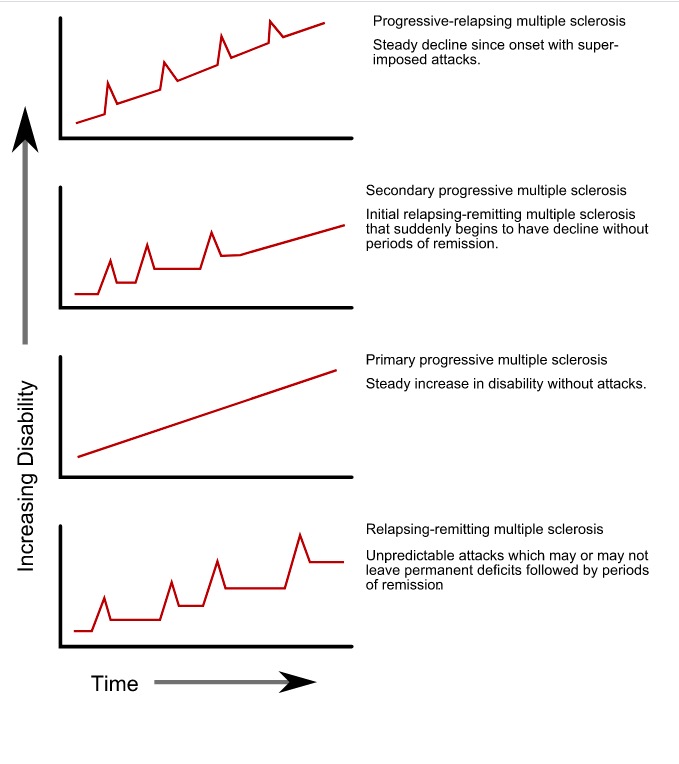Playlist
Show Playlist
Hide Playlist
Multiple Sclerosis: Introduction
-
Slides 01 Multiple Sclerosis Neuropathology II.pdf
-
Download Lecture Overview
00:01 Welcome back to neuropathology. 00:03 Here, we’ll take a look at demyelinating diseases. 00:06 We’ll walk through the most common conditions, and then as we journey through this further, we’ll get into more detail-oriented diseases. 00:13 It’s important that you pay attention to the definitions and pay attention to what is the underlying cause of the particular demyelinating disease. 00:21 We’ll begin our discussion by looking at multiple sclerosis. 00:25 And when you say multiple sclerosis, automatically, you should be thinking that this one of the most common demyelinating diseases that you shall see in the U.S. 00:33 The second thing that you want to do is pay attention to the definition. 00:37 And here, the two major components in this paragraph that are important to you is the separation into time and the separation in space. 00:47 The next question you want to ask yourself is, what is being separated in time? And that would actually be the neurologic defects. 00:55 So anytime that the patient is suffering from, let’s say a relapsing course or a neurologic defect, how much time is there in between in terms of intervals? And then secondly, what does space referring to? It’s referring to the actual demyelination, or in other words, the physical pathologic destruction that’s taking place of the white matter, and that would be separated by space. 01:21 The operative words here: time and space, time referring to neurologic deficit, and the space referring to the degeneration of the white matter. 01:31 The clinical course is here. 01:33 Now, one that’s the most common in terms of clinical course will be, and I’ll walk you through this quickly, but the one that I’ll spend a little bit more time with will be the top graph that you see, the top graph. 01:44 And by this, we mean that there’s going to be a relapsing and remitting type being the most common pattern. 01:50 The X axis, the horizontal line, represents the time course; meaning to say, in general, the age of the patient. 02:00 The Y axis represents the progressive deterioration or the severity of the disease. 02:07 So, the higher you go, the more severe is the disease. 02:10 Now, you’ll notice, please, that the top graph represents a most common pattern, which is the relapsing and remitting progression of multiple sclerosis. 02:23 The relapsing-remitting pattern is encountered in approximately 85% of patients with multiple sclerosis. It is characterized by unpredictable exacerbations of the disease followed by periods of remission. The patient usually recovers completely or almost completely from the attacks. 02:42 Approximately half of these patients progress to the secondary progressive pattern of the disease as you can see on the second graph. 02:50 This pattern is characterized by progressive deterioration without periods of remission after an initial relapsing-remitting course of the disease. Primary progressive multiple sclerosis, as you can see on the third graph, is characterized by progressive neurologic deterioration from the onset of disease. 03:10 The rarest pattern is the progressive-relapsing pattern of multiple sclerosis which is depicted in the fourth graph. 03:17 As you can see on the slide the patient is experiencing a progressive deterioration superimposed with attacks.
About the Lecture
The lecture Multiple Sclerosis: Introduction by Carlo Raj, MD is from the course Multiple Sclerosis.
Included Quiz Questions
Which of the following is a major component in the definition of multiple sclerosis?
- Separation in time and space
- Separation in time
- Separation in space
- Separation in time or space
- Pathology in the gray matter
Which of the following is the most common demyelinating disease in the United States?
- Multiple sclerosis
- Pick disease
- Charcot-Marie-Tooth disease
- Guillain-Barre syndrome
- Acute disseminated encephalomyelitis
Customer reviews
5,0 of 5 stars
| 5 Stars |
|
5 |
| 4 Stars |
|
0 |
| 3 Stars |
|
0 |
| 2 Stars |
|
0 |
| 1 Star |
|
0 |




